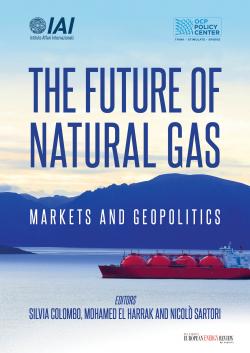The Future of Natural Gas. Markets and Geopolitics
Energy is at the core of the remarkable current transitions in the global economy and geopolitics, and natural gas plays a crucial role in these processes. In this context of rapidly evolving trends at the market level and developing dynamics between regional and global actors, The Future of Natural Gas aims at analysing the role of natural gas in the future energy mix by considering several key factors: the ambitious climate policies agreed by the international community, cost issues, and the role of technological innovation in the broader global gas picture. Starting from this analysis, the volume adopts a geographical approach to take into account the significant variability in the global perspective for gas markets. Focusing on major developments in the main supplying and consuming regions and countries, it considers geological factors, the development of internal policy and regulatory frameworks, the evolution of gas consumption patterns, as well as export and import strategies elaborated by key regional and global gas players. The Future of Natural Gas is thus an in-depth analysis of some of the fastest moving gas markets, attempting to define the trends of a resource that will have a decisive role in shaping the global economy and modelling the geopolitical dynamics in the next decades.
Results of the project "The Future of Gas Markets", conducted within the IAI-OCP Policy Center strategic partnership. Presented at the international seminar "The Future of Natural Gas: Markets and Geopolitics" organised in Rabat on 27 May 2016.
List of Contributors, p. 9-10
List of Abbreviations, p. 11-14
Foreword, p. 17-18
Introduction, by Lorenzo Colantoni, Silvia Colombo, Lilia Rizk and Nicolò Sartori, p. 19-24
1. The Future of Gas: The Transition Fuel?, by Luca Franza, Dick de Jong and Coby van der Linde, p. 25-40
1.1 The Case for Natural Gas as a Transition Fuel: Energy per Carbon Matters
1.2 The Failure of Policy-Making in Promoting Gas as a Transition Fuel
1.3 The Perception of Gas as a Politicised Commodity
Conclusions
2. On the Future of Global LNG Trade and Geopolitics, by Chi-Kong Chyong, p. 41-61
2.1 Evolution of LNG Trade and Pricing
2.2 Spot and Short-term LNG Trade
2.3 Short-term Limits to Inter-Regional LNG Trade and Global Gas Market Integration
2.4 Future LNG Developments and Implications for International Trade and Geopolitics
Conclusions
3. The United States as a New Gas Exporter, by David Koranyi, p. 63-78
3.1 US Natural Gas Production Potential
3.2 US Natural Gas Demand
3.3 Natural Gas Exports from the US
3.4 The Political and Regulatory Environment
3.5 Global LNG and Gas Market Developments
3.6 US LNG Export Competitiveness and Export Destinations
3.7 Energy Security Considerations in Europe and Asia
Conclusions
4. Gas in South America: Resources, Corridors and Policies, by Gonzalo Escribano, p. 79-99
4.1 Resources
4.2 Corridors
4.3 Gas Policies
4.4 Looking Ahead
5. The EU and LNG as a Flexible Tool for Energy Security: Constraints and Opportunities, by Giacomo Luciani, p. 101-116
5.1 The Global LNG Market: Developments and Perspectives
5.2 LNG in European Gas Supplies
5.3 The Commission’s Proposed LNG Strategy
Conclusions
6. Eastern Mediterranean Gas: Source of Prosperity for the Region?, by Ayla Gürel, p. 117-138
6.1 Eastern Mediterranean Gas Potential
6.2 Gas Discoveries and Development
6.3 Regional Political and Maritime Disputes
6.4 Markets for Eastern Mediterranean Gas
Conclusions
7. Western Mediterranean Gas: Towards North-South Convergence or Increasing Competition?, by Houda Ben Jannet Allal, p. 139-158
7.1 Natural Gas Demand Is Booming in the Western Mediterranean Region
7.2 Natural Gas Supply in the Western Mediterranean Region
7.3 Natural Gas Trade in the Western Mediterranean Region
7.4 Western Mediterranean Gas: Driver for North-South Convergence and Win-Win Cooperation
8. Winds of Change. Challenging Future for Russia’s Gas, by Agata Łoskot-Strachota, p. 159-179
8.1 Potential: Russian Gas Reserves and Production
8.2 Russian Gas on the Domestic Market
8.3 Decreasing Role of the CIS Market
8.4 Europe and Turkey
8.5 Challenges and Changes in Gas Trade with Europe
Conclusions
9. Sub-Saharan Africa: A Future Global Gas Player?, by Philippe Copinschi and Mark Smedley, p. 181-205
9.1 The Evolution of the Hydrocarbon Industry in West Africa
9.2 East Africa: A New Frontier for the Gas Industry
Conclusions
10. Asia’s Natural Gas and LNG Market Trends, by Wenran Jiang, p. 207-222
10.1 Asia’s Thirst for Natural Gas and LNG
10.2 Impact of the Oil Price Decline on Asian Gas Dynamics
10.3 China’s Gas and LNG Strategies
10.4 China-Russia Cooperation
10.5 Other Regional Dynamics
10.6 Prospects for Market and Policy
11. The Evolution of Japan’s LNG Strategies and Their Geopolitical Implications, by Jane Nakano, p. 223-238
11.1 The Growth of Natural Gas in the Japanese Energy System
11.2 The Fukushima Nuclear Accident and Natural Gas Renaissance
11.3 Diversifying the Supplier Country Pool
11.4 Diversifying LNG Procurement Models
11.5 Domestic Factors Influencing the Future of Gas in Japan
11.6 Blessing and Curse of Low Oil Prices
11.7 Geopolitical Developments Affecting Japanese LNG Strategies
Conclusions
Topic
Tag
Related content
-
Event14/12/2016
Natural gas from the Mediterranean region: what role in the energy transition after the Winter Package?
leggi tutto -
Event20/09/2016
Book Launch - The Future of Natural Gas: Markets and Geopolitics
leggi tutto -
Event20/09/2016
Global Energy Governance
leggi tutto



